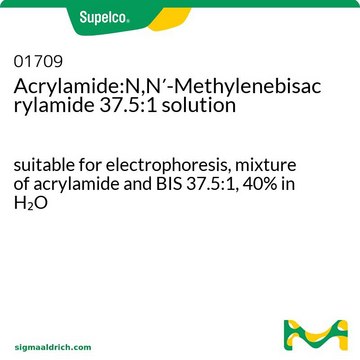A3699
Acrylamide/Bis-acrylamide solution
30%, BioReagent, suitable for electrophoresis, 37.5:1
Synonym(s):
30% Acrylamide/Bisacrylamide 37.5:1, Polyacrylamide solution
About This Item
Recommended Products
product name
Acrylamide/Bis-acrylamide, 30% solution, BioReagent, suitable for electrophoresis, 37.5:1
sterility
0.2 μm filtered
Quality Level
product line
BioReagent
form
liquid
feed ratio
37.5:1
technique(s)
electrophoresis: suitable
suitability
suitable for electrophoresis
storage temp.
2-8°C
2-8°C
SMILES string
NC(=O)C=C.C=CC(=O)NCNC(=O)C=C
InChI
1S/C7H10N2O2.C3H5NO/c1-3-6(10)8-5-9-7(11)4-2;1-2-3(4)5/h3-4H,1-2,5H2,(H,8,10)(H,9,11);2H,1H2,(H2,4,5)
InChI key
OCQZXMCGTAWGEQ-UHFFFAOYSA-N
Looking for similar products? Visit Product Comparison Guide
General description
Application
- in the preparation of polyacrylamide gel for photobleaching experiment
- as a constituent in the preparation of gel precursor solution and pore-gradient microgel precursor solution
- in the preparation of polyacrylamide gels during western blot analyses
Preparation Note
Not finding the right product?
Try our Product Selector Tool.
related product
Signal Word
Danger
Hazard Statements
Precautionary Statements
Hazard Classifications
Acute Tox. 4 Inhalation - Acute Tox. 4 Oral - Carc. 1B - Eye Irrit. 2 - Muta. 1B - Repr. 2 - Skin Irrit. 2 - Skin Sens. 1 - STOT RE 1 Oral
Target Organs
Peripheral nervous system
Storage Class Code
6.1C - Combustible acute toxic Cat.3 / toxic compounds or compounds which causing chronic effects
WGK
WGK 3
Flash Point(F)
Not applicable
Flash Point(C)
Not applicable
Personal Protective Equipment
Certificates of Analysis (COA)
Search for Certificates of Analysis (COA) by entering the products Lot/Batch Number. Lot and Batch Numbers can be found on a product’s label following the words ‘Lot’ or ‘Batch’.
Already Own This Product?
Find documentation for the products that you have recently purchased in the Document Library.
Customers Also Viewed
Our team of scientists has experience in all areas of research including Life Science, Material Science, Chemical Synthesis, Chromatography, Analytical and many others.
Contact Technical Service






